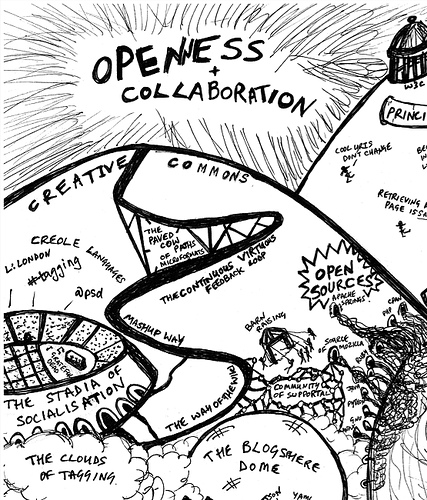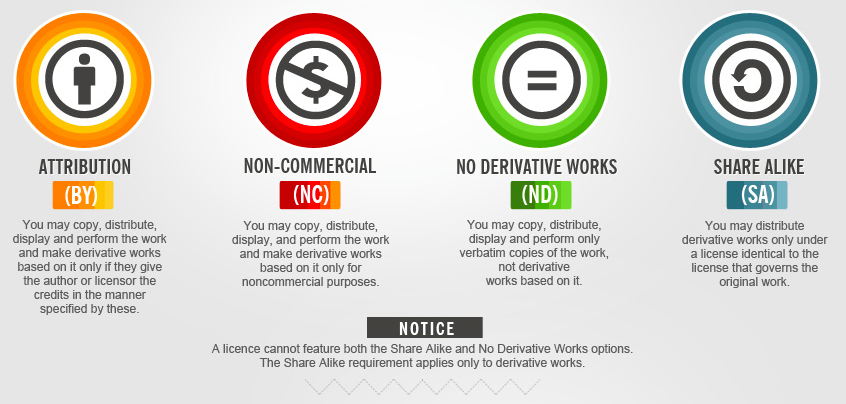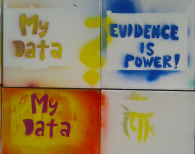3
Dissemination is a widely used term, and one that you probably have a general interpretation of, but it is useful to consider a formal definition first. The European Union defines dissemination as:
the process of making the results and deliverables of a project available to the stakeholders and to a wider audience.” (Source)
How can we make dissemination more in the open?
Learning Objectives
In this chapter you will gain an understanding of:
- how open dissemination differs from traditional dissemination
- the role that technology plays in open dissemination
- some of the benefits and disadvantages of open dissemination
- Creative Commons licenses
3.1. Open Access Publishing
One traditional aspect of dissemination that varies with open dissemination is the publication of research articles that may arise from a project. Over the past decade Open Access publishing has increased in uptake, with many research funders now mandating that any articles arising from their funding must be made openly available. Open Access is usually interpreted to mean “free online access to scholarly works”, although the Budapest Open Access Initiative (2012) gives a more formal definition, which encompasses not only free access in terms of cost, but also freedom from copyright constraints:
By ‘open access’ to this literature, we mean its free availability on the public internet, permitting any users to read, download, copy, distribute, print, search, or link to the full texts of these articles, crawl them for indexing, pass them as data to software, or use them for any other lawful purpose, without financial, legal, or technical barriers other than those inseparable from gaining access to the internet itself. The only constraint on reproduction and distribution, and the only role for copyright in this domain, should be to give authors control over the integrity of their work and the right to be properly acknowledged and cited. (Source)
Why Open Access?
Think about why we do research. Whether it is for public enrichment, scientific discovery, improving education or a country’s economy, “research can only advance by sharing the results, and the value of an investment in research is only maximized through wide use of its results.” (Source) Unrestricted access and unrestricted reuse of research results, including research data, are thus paramount to the advancement of our lives.
A project may decide from the outset that any publications will be published under an open access agreement, but this in turn may restrict the number of journals that can be considered. ‘How Open Is it?’, also available in a number of other languages, is a guide to help you determine how open is a journal and make informed decisions on where to publish. If you would rather have someone else do the work for you, then search The Directory of Open Access Journals.
Publishing open access may also have implications for the budget; many publishers charge Article Processing Charges (APC) to offset costs incurred in peer review management, journal production, online hosting and archiving, etc.
Activity 10: Advantages and Challenges of Publishing Open Access (20 minutes)
In your opinion, what are the advantages and disadvantages of publishing research and data openly?
Commentary
SPARC Europe write about the benefits and challenges of open access, which we reproduce here:
Benefits
Different stakeholders in the system of scholarly communications can and will benefit from no restricted access to research and data:
- Researchers as authors: immediate visibility for research output and thus increased visibility and usage of their results. Open Access may even lead to an increase of impact
- Researchers looking for information: access to literature everywhere, not only from a campus but also from any site with wifi access
- Funding agencies: increased return on investment (ROI), increased visibility
- Universities & research institutes: greater visibility, clearer management information
- Libraries: increased access for target audience, financially a more attractive model than the current subscription model
- Teachers & students: unrestricted access to material, enriched education, allowing equality of learning in poor as well as in rich nations
- Science: enhanced and accelerated research cycle
- Citizens & society: access to knowledge / access to the results of publicly funded research
- Enterprises: access to critical information
- Publishers: transparent business model, ultimate online article distribution, ultimate visibility for articles
Collective challenges in the system of scholarly communications
- The need for researchers to maximise the dissemination and impact of their research
- The need for readers to have access to the full corpus of relevant research literature
- The possibility of creating a continuum of integrated scholarly information, from raw data to peer-reviewed publications
- The development of open access models
- The emerging technical standards to facilitate open archiving
- The need for organisational structures to ensure access to digital archives
- The complexities of intellectual property rights and copyright issues
- Restrictive license conditions
- The disproportionate levels of library budgets spent on journal subscriptions, particularly in the science, technical, and medical (STM) areas
- The concentration of a significant part of scholarly output in the hands of a small but highly influential number of commercial publishers
- A widespread reluctance to cancel print until electronic archiving arrangements are secure
3.2 Impacts of Open Dissemination
Having looked at open access publishing in particular, we will now consider open dissemination more broadly. In the case of the OER Research Hub, our research has been supported and facilitated by ‘open’ dissemination. This open dissemination approach was an integral part of the initial project bid and has helped us meet and deliver our project goals.
We have deliberately:
- Created a project identity on various tools including Twitter, Scoop.It, YouTube and Slideshare
- Made the project blog the core part of our project identity
- Shared our research progress, outputs and methods on a regular basis, via our website/blogs and other media
- Created and used our OER Impact Map to encourage contribution and feedback from the rest of the OER community
- Shared our data openly, including survey results
- Shared our methodology and research instruments under a CC-BY license
But it is not always about choice. As we mentioned earlier, many funders now make it compulsory that research outcomes are openly archived. For example, the Research Data Policy of the Economic and Social Research Council (ESRC) in the UK stipulates that “All data created or repurposed during the lifetime of an ESRC grant must be made available for re-use or archiving within three months of the end of the grant.” (REF) The US government announced in 2013 that the results of federally funded research should be made freely available to the public generally within one year of publication. (REF)
Can this be detrimental to the impact of your research? An article by Y. Niyazov and colleagues, published in PLOS One in early 2016, argues that publishing open access improves the number of citations. (Source)
Activity 11: Can Open Dissemination make a difference? (15 minutes)
Consider the example of the OER Hub or any other project that you are familiar with. How do you think disseminating in the open in such a manner may benefit/hinder a research project?

Commentary
Here are some of the benefits of open dissemination highlighted by participants in the facilitated version of the course:
Working in the open potentially ensures more careful outputs”
… the possibility of building live, collaborative networks even after the initial research has been scoped and planned”
… the ability to connect with key stakeholders who are likely to be interested and impacted, and who may feel involved and invested to become part of the project”
Increased public engagement as “research is made relevant and accessible to the public and society”
The latter, however, can also be considered a limitation:
An open approach to research (…) may invite many distracting requests and queries. I’ve seen this happen in a project where there was so much interest to deal with that the museum had to formalise and somewhat restrict what had been an open door policy to their research project”
3.3. Facilitating Open Dissemination
With the advent of technology and the growing influence of social media communities, we now have a wider interpretation of ‘openness’. The concept of sharing outputs is no longer just viewed in a formal sense (e.g. a journal publication), but outputs can include informal ideas, suggestions and presentations.
Here are some examples of how technology has been supporting openness to a wider community:
- Stephen Downes curates blogs on a wide range of topics relating to educational technology, and publishes a daily and weekly digest.
- True Stories of Open Sharing is compiled by Alan Levine and “…shares moving, personal stories that would not have been previously possible, enabled by open licensed materials and personal networks.”
- Ten things you need to know about ORCID right now highlights the importance of having a permanent identifier for researchers.
Activity 12: Tools that support Open Dissemination (30 minutes)
Think about some technologies that support and facilitate open dissemination (e.g. Facebook, Twitter, blogging platforms, Flickr, SlideShare, Scoop.it, etc.). Select which of these tools you would use to disseminate your research and reflect on why.
In selecting a channel, think about your project’s audience and what they could easily gain access to. For example, does your community have ready access to internet? Is your community active on a particular social network? Does your community regularly engage with blogs?
Commentary
Here are some thoughts and ideas for tools to disseminate research from previous course participants:
It depends heavily on what you’re doing. From where I’m sitting, Flickr would be entirely inappropriate, mostly because my audience isn’t there, but partially because Flickr isn’t set up for science. Figshare is pretty awesome, partially because you do get a DOI for your work, which makes it citable, and DataDryad is becoming more popular. SlideShare seems to be the location of choice for presentations, though some people host their own. (…) You’d want to make sure your location of choice supports the metadata that your field expects (or would like to see) to ensure your information actually can be viewed, read, and reused.”
My next project could be based on a guerilla research approach, and I would use blogging as the main media/genre (with WordPress as the platform) for dissemination during the research process, as blogging gives the possibility to present coherent thought of some length with the room for commenting and having people follow. At the same time blogging is a way of disseminating that is well accepted in the communities that could be interested in the project and that I could be interested in dialogue with. (…) And then as a media/genre, a blog gives the possibility to embed videos, SlideShares, Tweets and link to other kinds of social media, and thus a blog can be a kind of repository for the different outputs of a project. To spread the news, Twitter is a must. And if it does end up with an article, an open repository would be an option.”
Some of my research project’s audience has access to the internet so would follow the blog, look at photos on Flickr and a few may use Twitter. Others use Facebook where the project has a presence, so my online dissemination strategy for research is usually to write a blog post about it explaining the latest activities and findings then tweet the post and share it on Facebook. If there are any related images these are posted within the blog post or on Flickr. Raw data in spreadsheet format will soon be shared online via Google spreadsheet, inviting those who are interested in participating in the research activity to contribute as well.”
3.4. Open Licensing
For dissemination to be considered as ‘open’, reuse of a project’s outputs, be it data, presentations, video or articles, would be explicitly encouraged. One way of retaining ownership of the copyright for your content while showing other people that it is “open” and can be reused in specific ways is to openly license them. One popular range of open licenses is provided by Creative Commons (CC).
The following image explains what each of the licenses allow you to do:

These licenses can be combined. For example, the image reproduced right above this paragraph has been released under a CC BY-SA license, which means that it can be reused as long as it is attributed and shared under the same terms. The resource creator has not added any restrictions with regard to adapting the resource (note that we have cropped it from the original) or using it for commercial purposes.
The same applies to research outputs. For example, the survey data that OER Research Hub collected is available on Figshare under a CC BY license: this means that anyone can access the data file, download it, add more data to it, carry out a different analysis, etc. as long as OER Research Hub are cited as the original provider of the data.
You can also read more about how to license different types of research outputs (for example data or databases) in the guidelines available via the Creative Commons wiki.
Activity 13: Choosing the most appropriate Creative Commons license for your needs (30 minutes)
Read Claire Redhead’s blogpost Why CC-BY? and reflect on which CC license you would choose to release your research outputs.

Commentary
As Clare Redhead notes there are a number of arguments for and against using more or less restrictive Creative Commons licenses. Here are some of the reasons previous course participants gave for their use of specific Creative Commons licenses:
Context is everything: I work with data and methods and science, and I get paid with grant money. My motivations in publishing openly are to ensure other researchers and data enthusiasts can read and use my stuff, so my concerns are very different from, say, an artist’s concerns. If someone does something cool with my data and cites me, that’s a good thing. If someone takes an artist’s awesome image and sells it on journal covers without telling anyone, that’s not okay. (…) Because reputation is important in research, my answer is kind of based on the zeitgeist in the field. I’d tend towards the least restrictive license I can get away with given institutional and publication guidelines, and it looks like it’s possible in many cases to go straight for CC-BY.”
Well, I’m still researching this and considering options. I’ve seen a couple of artists who also make moving image who have some clips on their website which are protected and some which are freely available to download and use under a creative commons license. (…) I think that in my own work I am still confused about what might be research which could be openly available to others, and what is my core work and creative capital. There are so many overlapping layers and edges. And since research is not my core activity, but part of my art practice, there are additional formatting and time issues which need to be considered. However, open research is surely about establishing conversations about ideas, and that’s a good place to start from.”
3.5 Planning Your Own Research Project
To end this section of the course we would like you to think about your own research interests and plan your own mini-research project. This activity should bring together all of the ideas we have discussed so far.
Activity 14: Mini-Research Project (45 minutes)
Think of all the different things you would need to consider when planning a research project (you can look back at Chapter One if you need a reminder). In what ways could you incorporate open research practices (such as sharing your data or being open about your progress) into your research project?
Download the Planning your own Research Project pro forma (PDF, Word, RTF) and use it to help organise your thoughts. In what ways (if any) could openness make a difference to your research process?
Further reading
- Martin Weller, The openness-creativity cycle in education: a perspective
- Martin Weller, The Virtues of Blogging as Scholarly Activity
- David Wiley and Cable Green, Why Openness in Education?
- The Open University’s OpenLearn Course on Open Education
